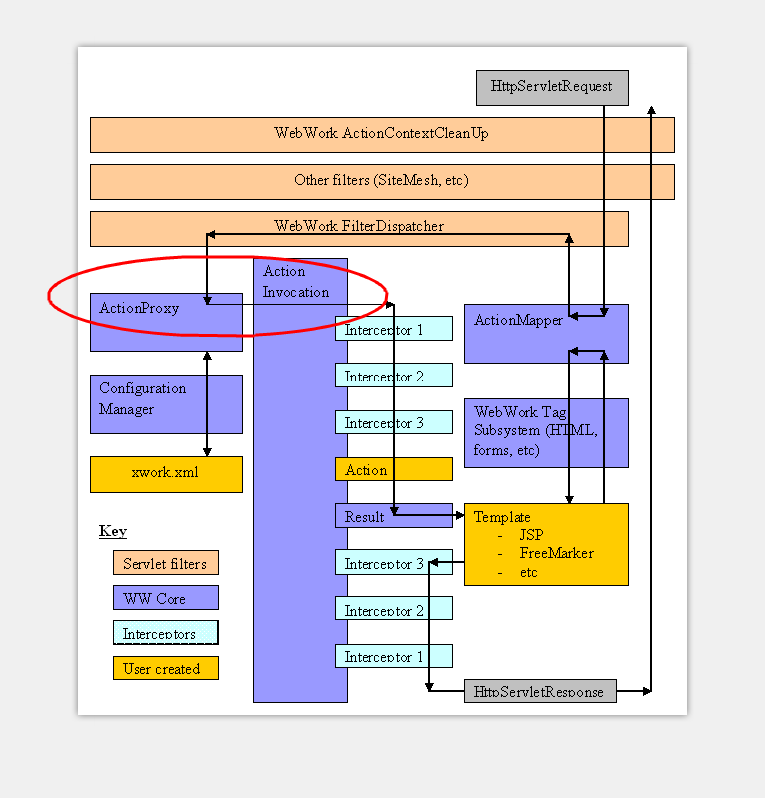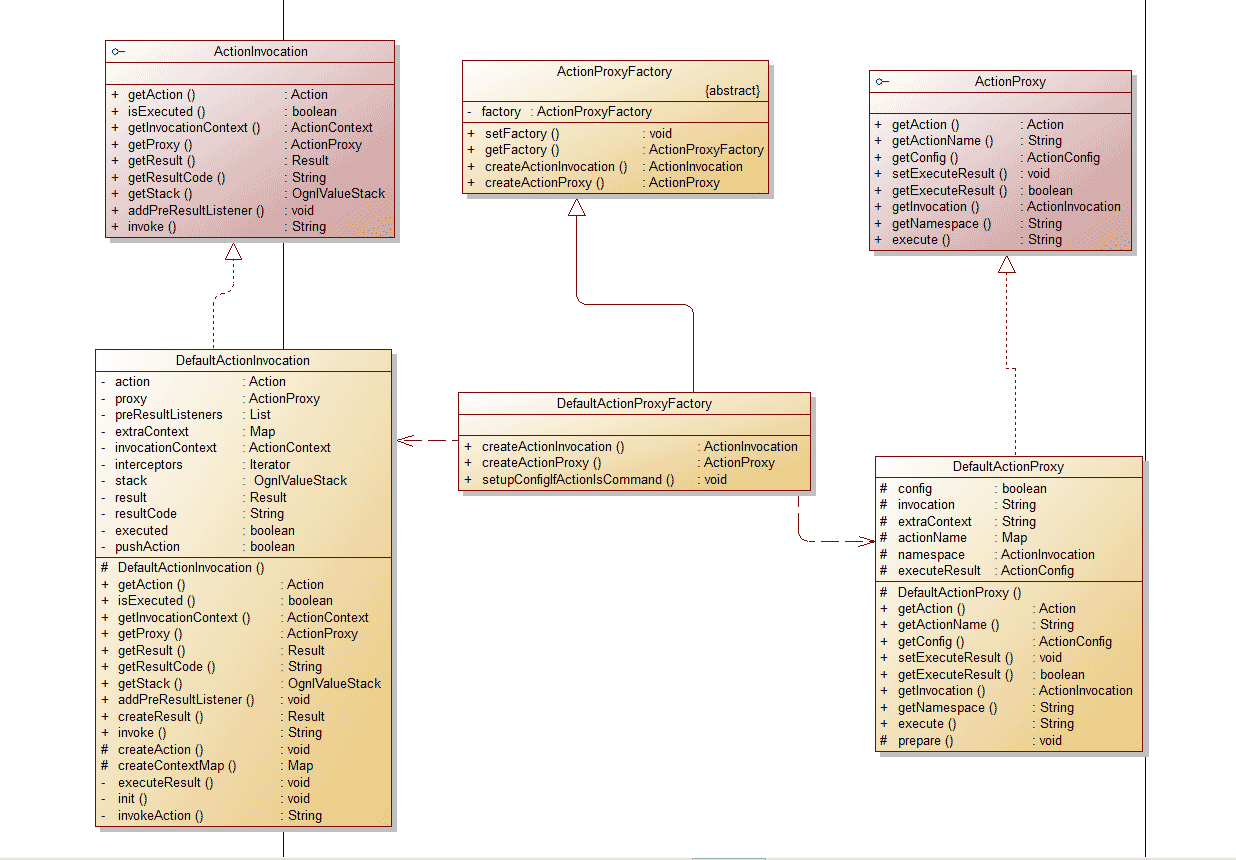이 글에서는 주로 세 가지 측면을 통해 호출되는 웹워크 액션과 관련된 지식을 소개합니다.
1. 프레임워크 클래스 관계 부분
2.Webwork는 웹 매개변수를 획득하고 패키징합니다
3.DefaultActionProxyFactory, DefaultActionProxy, DefaultActionInvocation
그 과정에서 마침내 웹워크의 핵심 비즈니스 클래스를 요약하기 시작합니다. 웹워크는 클라이언트가 전달한 웹 매개변수를 다시 패키징하고 비즈니스 Action 클래스를 실행하며 실행 결과를 피드백합니다. 이 소스 코드 분석은 흐름에 해당합니다. 아래 그림의 빨간색 상자는 WebWork 프레임워크입니다.

1. 프레임워크 클래스 관계 부분

2.Webwork는 웹 매개변수를 획득하고 패키징합니다
•각 웹 프레임워크는 사용자의 편의를 위해 웹 요청 매개변수를 어느 정도 패키징하며, 물론 웹워크도 예외는 아닙니다.
•Webwork의 응답요청별 입력방법 :
public void service(HttpServletRequest request, HttpServletResponse response) throws ServletException {
try {
if (encoding != null) {
try {
request.setCharacterEncoding(encoding);
} catch (Exception localException) {
}
}
if (locale != null) {
response.setLocale(locale);
}
if (this.paramsWorkaroundEnabled) {
request.getParameter("foo");
}
request = wrapRequest(request); //封装 request请求
serviceAction(request, response, getNameSpace(request), getActionName(request), getRequestMap(request), getParameterMap(request), getSessionMap(request), getApplicationMap());
} catch (IOException e) {
String message = "Could not wrap servlet request with MultipartRequestWrapper!";
log.error(message, e);
sendError(request, response, , new ServletException(message, e));
}
}•요청 및 응답 매개변수를 수락하고 요청 매개변수를 캡슐화합니다. 이 캡슐화는 주로 프로젝트의 파일 업로드 요청, 다양한 유형의 파일 내보내기 등과 같은 멀티미디어 요청의 특수 처리에 사용됩니다.
•요청을 래핑한 후 서비스 메서드는 ServletDispatche.serviceAction() 메서드를 호출하고, Action 비즈니스 로직을 호출하기 전에 6개의 메서드 getApplicationMap, getSessionMap, getRequestMap, getParameterMap, getActionName 및 getNameSpace를 호출하여 전희를 시작합니다.
• getNameSpace 메소드는 작업이 속한 네임스페이스를 얻는 데 사용됩니다. 예: "/my/MyAction.action"은 "/my"를 반환합니다.
protected String getNameSpace(HttpServletRequest request){
String servletPath = request.getServletPath();
return getNamespaceFromServletPath(servletPath);
}
public static String getNamespaceFromServletPath(String servletPath){
servletPath = servletPath.substring(, servletPath.lastIndexOf("/"));
return servletPath;
}•getActionName은 요청된 작업의 이름을 반환합니다. 예: "MyAction.action"은 "MyAction"을 반환합니다.
protected String getActionName(HttpServletRequest request){
String servletPath = (String)request.getAttribute("javax.servlet.include.servlet_path");
if (servletPath == null) {
servletPath = request.getServletPath();
}
return getActionName(servletPath);
}
protected String getActionName(String name){
int beginIdx = name.lastIndexOf("/");
int endIdx = name.lastIndexOf(".");
return name.substring(beginIdx == - ? : beginIdx + , endIdx == - ? name.length() : endIdx);
}• getRequestMap 메소드는 요청의 모든 속성을 포함하는 Map을 반환합니다. 구체적인 구현 클래스는 다음과 같습니다.
protected Map getRequestMap(HttpServletRequest request){
return new RequestMap(request);
}•getParameterMap 메소드는 요청의 모든 매개변수를 포함하는 Map을 반환합니다.
protected Map getParameterMap(HttpServletRequest request) throws IOException{
return request.getParameterMap();
}•getSessionMap 메소드는 세션의 모든 속성을 포함하는 Map을 반환합니다. 구체적인 구현 클래스는 다음과 같습니다.
protected Map getSessionMap(HttpServletRequest request){
return new SessionMap(request);
}•getApplicationMap 메소드는 Application의 모든 속성을 포함하는 Map을 반환합니다. 구체적인 구현 클래스는 다음과 같습니다.
protected Map getApplicationMap(){
return new ApplicationMap(getServletContext());
}•WebWork가 요청의 속성과 매개변수, 세션의 속성, 애플리케이션의 속성을 맵으로 캡슐화하는 이유는 단지 웹워크 자체의 사용 편의성을 위해서입니다.
public void serviceAction(HttpServletRequest request, HttpServletResponse response, String namespace, String actionName, Map requestMap, Map parameterMap, Map sessionMap, Map applicationMap) {
HashMap extraContext = createContextMap(requestMap, parameterMap, sessionMap, applicationMap, request, response, getServletConfig());
extraContext.put("com.opensymphony.xwork.dispatcher.ServletDispatcher", this);
OgnlValueStack stack = (OgnlValueStack) request.getAttribute("webwork.valueStack");
if (stack != null) {
extraContext.put("com.opensymphony.xwork.util.OgnlValueStack.ValueStack", new OgnlValueStack(stack));
}
try {
ActionProxy proxy = ActionProxyFactory.getFactory().createActionProxy(namespace, actionName, extraContext);
request.setAttribute("webwork.valueStack", proxy.getInvocation().getStack());
proxy.execute();
if (stack != null) {
request.setAttribute("webwork.valueStack", stack);
}
} catch (ConfigurationException e) {
log.error("Could not find action", e);
sendError(request, response, 404, e);
} catch (Exception e) {
log.error("Could not execute action", e);
sendError(request, response, 500, e);
}
}•먼저 ServiceAction은 createContextMap을 호출하여 액션 컨텍스트(extraContext)를 생성합니다. JavaServlet 관련 객체를 래핑하여 extraContext Map 객체에 넣습니다.
• 그런 다음 이전 요청에 사용 가능한 값 스택이 있는지 확인하세요. 그렇다면 이 요청에 사용할 extraContext Map 객체에 넣으세요.
•ActionContext(com.opensymphony.xwork.ActionContext)는 Action이 실행될 때의 컨텍스트입니다. 컨텍스트는 컨테이너로 간주될 수 있습니다(사실 여기의 컨테이너는 Action에 필요한 정보를 저장합니다). 객체를 실행할 때 사용합니다.
• ServletActionContext(com.opensymphony.webwork.ServletActionContext), 이 클래스는 JavaServlet 관련 개체에 대한 직접 액세스를 제공하는 ActionContext를 직접 상속합니다.
•OgnlValueStack의 주요 기능은 표현 언어를 통해 개체의 속성에 액세스하는 것입니다.
3.DefaultActionProxyFactory, DefaultActionProxy, DefaultActionInvocation
드디어 전희가 끝났고, Action에서 호출한 세 형제가 가장 중요한 작업을 수행하기 위해 무대에 오르려고 합니다. 다음 세 줄의 코드는 xwork.xml의 읽기 코드와 동일합니다. 웹워크 학습 경로 점프를 요청하기 전에 (5) 매우 유사한 글쓰기 및 디자인:
ActionProxy proxy = ActionProxyFactory.getFactory().createActionProxy(namespace, actionName, extraContext);
request.setAttribute("webwork.valueStack", proxy.getInvocation().getStack());proxy.execute(); •通过由前面获得的namespace、actionName、extraContext 创建调用代理 ActonProxy 实例,这里也就是 DefaultActionProxy,之后调用 了 ActionProxy.execute 方法来执行我们逻辑Action.execute。
•ActionProxy是一个接口,ActionProxyFactory则是一个抽象类,默认情况下它们是通过 DefaultActionProxy和DefaultActionProxyFactory来完成操作的。
•在 ActionProxyFactory 中有一个静态变量 factory ,它指向的是一个 DefaultActionProxyFactory 实例,代码如下:
static ActionProxyFactory factory = new DefaultActionProxyFactory();
public static void setFactory(ActionProxyFactory factory){
factory = factory;
}
public static ActionProxyFactory getFactory(){
return factory;
}• DefaultActionProxyFactory 的 createActionProxy 方法返回了 DefaultActionProxy 实例。
public ActionProxy createActionProxy(String namespace, String actionName, Map extraContext)throws Exception {
setupConfigIfActionIsCommand(namespace, actionName);
return new DefaultActionProxy(namespace, actionName, extraContext, true);
} •DefaultActionProxy的构造函数
protected DefaultActionProxy(String namespace, String actionName, Map extraContext, boolean executeResult) throws Exception{
if (LOG.isDebugEnabled()) {
LOG.debug("Creating an DefaultActionProxy for namespace " + namespace + " and action name " + actionName);
}
this.actionName = actionName;
this.namespace = namespace;
this.executeResult = executeResult;
this.extraContext = extraContext;
this.config = ConfigurationManager.getConfiguration().getRuntimeConfiguration().getActionConfig(namespace, actionName);
if (this.config == null)
{
String message;
String message;
if ((namespace != null) && (namespace.trim().length() > 0)) {
message = LocalizedTextUtil.findDefaultText("xwork.exception.missing-package-action", Locale.getDefault(), new String[] {
namespace, actionName });
} else {
message = LocalizedTextUtil.findDefaultText("xwork.exception.missing-action", Locale.getDefault(), new String[] {
actionName });
}
throw new ConfigurationException(message);
}
prepare();
}•将传入的名称空间、 Action 的名字等参数赋予本地变量,接着通过 ConfigurationManager 获得当前请求的 Action 的配置信息[这里在5中已经描述过]。接着调用自身的 prepare 方法创建一个 ActionInvocation 对象赋予自身变量 invocation。在之后的 execute 方法中通过操纵invocation 来实现我们自己写的Action 的调用。
protected void prepare() throws Exception {
this.invocation = ActionProxyFactory.getFactory().createActionInvocation(this, this.extraContext);
}以上所示是针对Webwork中Action 调用 的相关知识,希望对大家有所帮助。